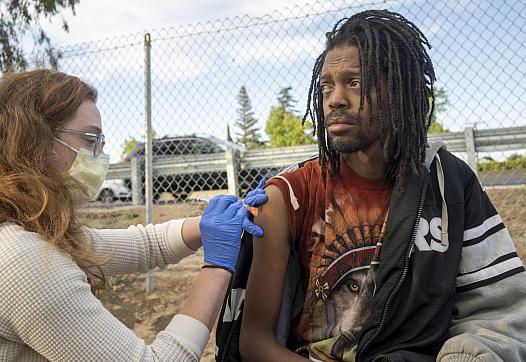Sacramento’s Black community takes charge of its own health, vaccinations
The story was originally published in The Observer with support from the USC Annenberg Center for Health Journalism's 2021 California Fellowship.
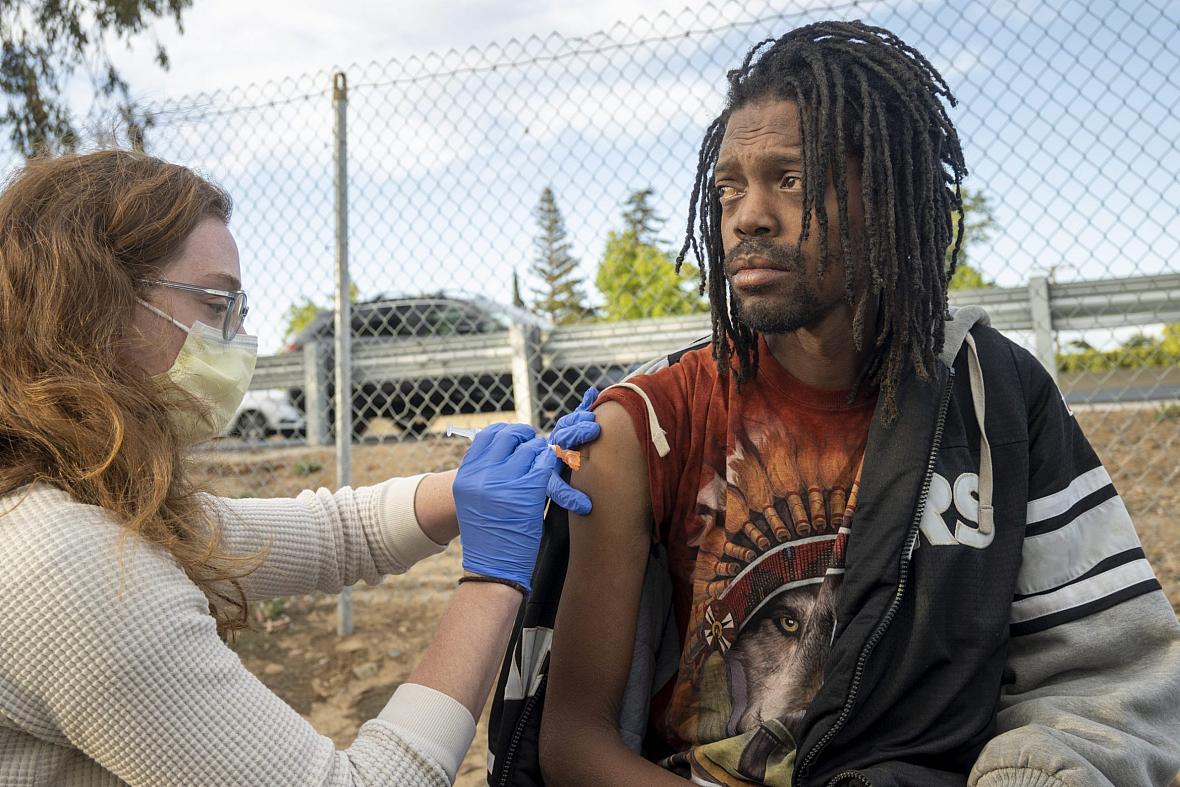
The Community Lead Advocacy Program (CLAP) brought vaccines to a homeless encampment in the Valley Hi area. Javon Coleman was among those who took advantage of the opportunity.
Credit: Russell Stiger Jr. / OBSERVER
As a Black female neurosurgeon in affluent Folsom, Dr. Kawanaa Carter is paid well, but has spent the last six months healing the community for free.
Armed with the knowledge that African Americans are disproportionately impacted by the pandemic — and the data to back it up — Dr. Carter and other advocates have stepped up to vaccinate thousands throughout the region. They’ve focused on areas like Del Paso Heights, North Highlands, Oak Park and Meadowview.
“I haven’t made a dime,” Dr. Carter said of her efforts to ensure that some of the area’s most vulnerable residents are protected against the deadly COVID-19 virus. It’s the level of commitment that’s needed, she says.
Despite being among the hardest hit by COVID-19 early on, African Americans in California have gotten the vaccine at starkly lower rates than other groups. California’s Surgeon General Dr. Nadine Burke-Harris places the number of Blacks statewide who have received at least one vaccine dose at 50 percent. In comparison, only 11 percent of Asian Americans remain unvaccinated, 36% of Whites and 50% of Latinos.
While Dr. Burke-Harris is encouraged by the improvement in the state vaccination rate for Blacks, she readily admits that “there is still a lot of work to do.”
As of August 9, 49.2 % of Sacramento County was fully vaccinated and 35.6% of African Americans have received the vaccine. While African Americans make up 10 percent of the county’s overall population, to date, African Americans make up just 7% of all doses administered locally. Just a month ago, Blacks had been woefully behind other ethnic groups. Asian Americans are still the most vaccinated at 68.9%, Latinos are at 35% and Whites are at 45.5%.
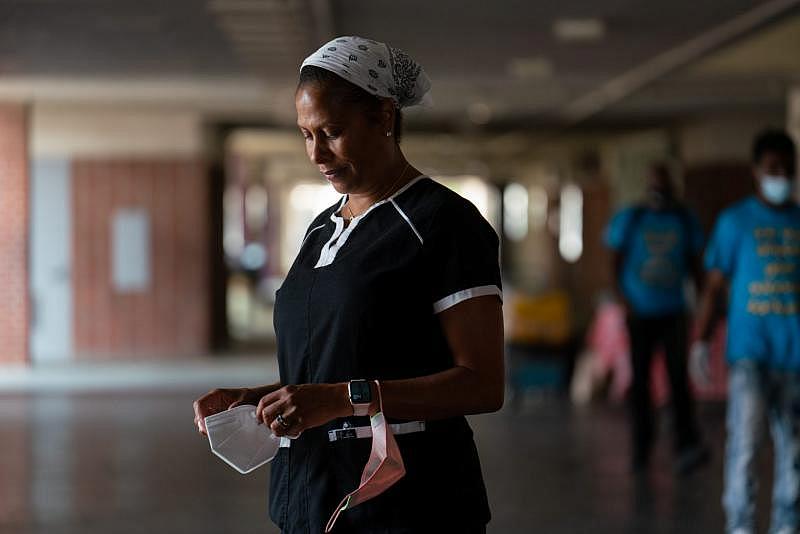
When vaccines were slow to get to communities of color, Dr. Kawanaa Carter says she couldn't sit on the sidelines and do nothing. The local neurosurgeon has sponsored a number of clinics to protect area residents. (Credit: Louis Bryant III/OBSERVER)
In Sacramento County, 12.9% of the 120,417 people who had contracted the virus (as of August 9) have been Black and of the 1,800 people who have officially died of COVID-19, 10.7% have been Black.
Back in February, after stakeholders made repeated requests for data, Gov. Gavin Newsom announced that of the thousands who had received the vaccine, just 3% statewide were African American. Sacramento County numbers weren’t much better at 4%.
That same month, a group of African American leaders, Sacramentans Advocating for Vaccine Equity (SAVE), called out county officials, demanding action and better outreach for a “fair and equitable distribution of the COVID-19 vaccine.” SAVE had previous success in getting the City to open several neighborhood testing sites for those who had problems accessing larger, harder to reach mass testing locations.
County officials also caught flack from community members in August 2020 when The Sacramento OBSERVER revealed that 90% of the $181 million they received in federal CARES Act money for COVID-19 response had gone to cover Corrections costs, costs that included salaries and benefits for the Sheriff’s and probation departments. Outraged residents called the move a “bait and switch.”
"FOLKS ARE DYING"
When talks of a vaccine began in earnest, Gov. Newsom promised that people of color would not be forgotten. A statewide Community Vaccine Advisory Committee was formed and chaired by Dr. Burke-Harris, who is Black, but leaders and activists in the streets seemed disconnected from it. Despite promises that vaccine distribution would be equitable, efforts to ensure equal access to the life-saving shot have largely been community driven.
Dr. Gina Warren, the co-founder of the Neighborhood Wellness Foundation that partnered with Dr. Carter for the Del Paso Heights vaccination clinic, said distribution was anything but equitable.
“It wasn’t that at all,” Dr. Warren shared.
“We know who’s dying,” she said, adding that a member of her staff was among those who was almost claimed by the virus. That staffer did lose a relative.
Local activist Faye Wilson-Kennedy, who is a leader with the Sacramento Poor People’s Campaign and a spokesperson for the Sacramentans Advocating for Vaccine Equity collaborative, echoed Dr. Warren’s sentiment, after she and other Black senior friends — many of whom also have chronic illness like asthma and diabetes — had difficulty securing vaccine appointments.
“We have to take care of ourselves. Folks are dying,” Ms. Wilson-Kennedy shared.
The Black community has had to employ the “it takes a village” stance, Dr. Warren says.
“It takes three (villages). It’s all hands on deck …When we do that, it’s amazing what we’re able to get done,” she shared.
That has been the case throughout the state and while officials rolled out catchphrases like “Vaccinate all 58” and encouraged people to “put the unity in immunity,” grassroots advocates rolled up their sleeves and made it happen.
Locally, groups such as the Sacramento Poor People’s Campaign and the Community Led Advocacy Program (CLAP) found ways to protect Sacramento’s ever-growing homeless population, pairing chances to get vaccinated with food, clothing and toiletry giveaways. That tactic was similarly applied in other regions throughout California. In San Francisco, UCSF epidemiologist Dr. Kim Rhoads leads a collective called Umoja Health that focuses on the Black community’s COVID needs and hosts neighborhood pop-up clinics that are credited with San Francisco getting 80% of those living in its most vulnerable areas to get vaccinated. Dr. Rhoads often pairs with a Latino task force, Unidos en Salud (United in Health), to reach Black and brown communities like Mission, Bayview, Hunters Point, the Tenderloin, as well as similar areas in Oakland. In San Jose, volunteers calling themselves “vaccination fairies,” helped Spanish-speaking workers navigate technology to obtain hard-to-come-by appointments. In Los Angeles, the St. John’s Well Child & Family Center purchased special freezers on its own to store vaccines and set up call hotlines to reach its low-income patients. In Pasadena, a contract tracing team from the Public Health Institute partnered with the City to “close the gap” by following up with prior COVID cases and contacts about their vaccination status and schedule appointments.

Dr. Olivia Kasirye, Sacramento County’s Public Health Officer has driven the County’s response to COVID-19. Dr. Kasirye helped launch mass vaccination sites and trailers to go to areas like Valley Hi, where vaccination rates have been low. Credit: Ray Johnson / OBSERVER
Recognizing that “the pandemic did not affect California communities equally,” the state started using a vaccine equity metric and Gov. Newsom vowed in March to devote 40% of the doses California received from the federal government to people living in “hardest hit” areas. At the time, 40 percent of the state’s COVID cases and deaths were occuring in the lowest quartile of the Healthy Places Index (HPI), which scores neighborhoods based on life expectancy and conditions such as economy, education, healthcare access, housing, clean environment, transportation, and social environment. The HPI is similar to the Centers for Disease Control and Prevention’s (CDC) Social Vulnerability Index. Higher HPI scores correlate to better health outcomes, while those with lower scores reflect worse health outcomes and earn “vulnerable” status.
Sacramento County Public Health Officer Dr. Olivia Kasirye said much of the increased allotments went to the Central Valley and Los Angeles County, areas heavily populated by essential farm workers.
It was a year into the pandemic and locally, communities of color were still without clinics dedicated to them.
A month later, Sacramento County identified trouble spots, zip codes with the lowest vaccination rates, but members of the Sacramentans Advocating for Vaccine Equity group weren’t impressed, as these areas had been waving their hands in the air, as if saying, “Hey, notice me” for months by then. County officials doubled down on their assertion that they were relying on “trusted messengers” to reach underserved neighborhoods and that many of the community efforts still relied on County support.
“We are very excited to see organizations and members of our community step up to champion this effort and lead the way for a more equitable system in Sacramento County,” said Dr. Kasirye, who is Black.
LOCAL LEADERS DON’T WAIT FOR THE GOVERNMENT TO ACT

Efforts to get locals vaccinated remain a high priority as Sacramento County is seeing an increase in cases and hospitalizations since reopening on June 15. Credit: Ray Johnson / OBSERVER
In May, President Biden set a goal of having 70% of the adult U.S. population getting at least one dose of the vaccine by July 4 — an independence from COVID-19. According to the CDC, 172 million Americans, about 67% of the adult population, had received at least one dose by the holiday weekend. Roughly 47% had received both. Having fallen short, Biden announced a new “door-to-door” plan on July 8 to get more people vaccinated across the country.
Locals were two steps ahead of him, having already realized it was time to meet people where they were.
The Greater Sacramento Urban League (GSUL) started having pop-ups in the parking lot of Oak Park’s St. Paul Missionary Baptist Church when it shut down as a vaccination site on May 28. The church had partnered with the UC Davis Medical Center to provide the free shots, after Administrative Assistant Lamont Harris “got the run around” from the County in its attempt to go from a neighborhood testing site to a vaccination location for Oak Park residents. The GSUL team also started canvassing the area based on Census tract data. Outgoing President and CEO Cassandra Jennings is a long-time member of the church and championed for Blacks to fill out the Census in 2020, even while sheltering in place during the throes of the pandemic, citing the importance of having info to use when resources are being debated and allotted.
Dr. Carter often gets calls from other community advocates looking for vaccines for workers in hard-to-reach areas. Some have difficulty finding clinics open during their off hours and others don’t trust providers at locations that they can get to. Calls come in and Dr. Carter jumps in her car and goes. She has been cautioned against providing such “concierge service,” but she remains undaunted.
“If I don’t do it, who’s going to?” she said.
Dr. Carter is particularly concerned about reaching Black men, who have avoided vaccination for a multitude of reasons ranging from a distrust of healthcare professionals to misinformation they’re finding on social media sites.
“Black men between the ages of 15 and 45 are really difficult so we have to work on that,” she said. “We think we’re only going to get them by going door-to-door.”
A $95,000 grant from Kaiser will get her team out of their own vehicles and into a mobile unit going forward. Dr. Carter also met with former California Attorney General turned U.S. Secretary of Health and Human Services Xavier Becerra to discuss monies that the federal government has available “for our community.”
“We really need the help,” she shared. “We’ve been working on volunteer power for a long time and now with this extended and targeted effort, you really have to incentivize people,” she said of those who still need the vaccine and those working to make sure they get it.
She’s also planning to pursue a partnership with Dr. Kasirye to secure a FEMA vehicle for mobile vaccines.
“The State of California turned it down,” she said. “They said they didn’t need it, so we have to find another way to get it.”
"SHEROS" FIGHT VACCINE HESITANCY, LACK OF RESOURCES
Locals were angered last year upon learning that a $90 million request from Dr. Kasirye for public health costs related to COVID-19 was initially denied. Included in the ask was the cost of two vehicles for pop-up COVID-19 testing and to help as the pandemic continued on into 2021. On May 19, the County debuted new mobile trailers at the Valley Hi Library, in the heavy hit 95823 zip code, and partnered with the National Guard to host a clinic there. Some voiced a hesitancy to rely on a National Guard that stared them down during the contentious George Floyd protests of last summer.

Local pediatrician Dr. Beatrice Tetteh has administered the vaccine to people during pop up and door to door efforts hosted by the Greater Sacramento Urban League. Her doctor’s office in the South Land Park area is also a COVID-19 testing location. Credit: Ray Johnson / OBSERVER
The GSUL talked about vaccine hesitancy in general during a virtual discussion “Jazz & Vaxx” on June 18. The event featured comments from local Black pediatrician and family doctor, Dr. Beatrice Tetteh. The GSUL tapped Dr. Tetteh to administer the vaccine at its St. Paul parking lot clinics. Her South Land Park Drive office had previously served as a COVID-19 testing site. Drs. Carter and Tetteh were called “sheroes” for their “relentless commitment” to community vaccination efforts.
During the “Jazz & Vaxx” discussion, Dr. Tetteh dispelled myths about the vaccine and shared “the science behind it.” Similarly, CDC officials previously touted the contributions of Dr. Kizzmekia Corbett, who helped develop the Moderna vaccine, to convince African Americans that the vaccines are safe. While most were happy to give a Black woman “props” many still weren’t convinced. The event was hosted by KDEE smooth jazz personality Leon Guidry, who admitted his initial hesitancy and mistrust of the vaccine. Guidry finally got the shot so that he could be around his young granddaughter.
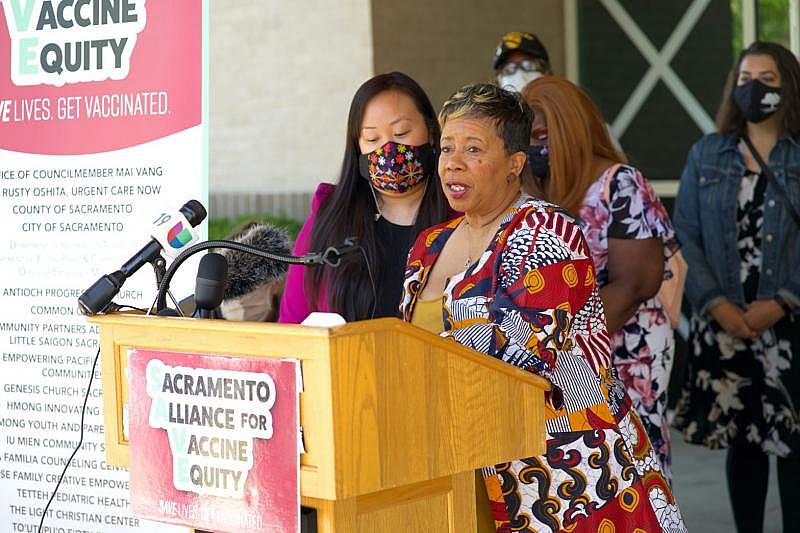
City Councilmember Mai Vang, left, and a coalition of other community-based organizations, like the Sacramento NAACP, led by Betty Williams, right, in bringing the vaccine to vulnerable residents in South Sacramento. Vang, who represents District 8, says the group will continue to work for language equity, vaccine access and much-needed community investment. (Credit: Special to OBSERVER)
Getting vaccinated right before Easter allowed Ms. Jennings to gather with her children and grandchildren all in one space for the first time in more than a year and later, to get on a plane for the first time since the pandemic. She wants the same freedom for others, she says. The freedom to hug someone without fear, to sit next to someone at a public concert.
“We’re starting to come out of it, but I don’t want anyone to be misled that it’s over,” Ms. Jennings cautioned.
“The neighborhoods that we serve, the under-resourced neighborhoods and people of color, have been falling behind. It’s more than the economy, it’s our health. It’s about when do we really start taking charge of our health and our lives? It starts with this vaccine, then we can do all the other things we want to do (to address) all the things that are killing our community faster than anybody else,” she continued.
ADMINSTERING VACCINES WHERE THEY ARE NEEDED MOST
Activists argued that the Black community’s predisposition to chronic health conditions that make them more susceptible to COVID-19 should have placed them higher on the vaccination distribution list. On the state’s eligibility list, the vaccine first went to those in long-term care facilities, seniors 65 and older and later first responders. Counties were getting limited supply of the vaccine and even when people became eligible to get it, that didn’t mean that locations near them could accommodate.
Appointments were hard to come by. In some cities, codes were given out, but people from other more affluent areas got access to them and jumped ahead. Others flat-out lied in order to get the vaccine early. From the beginning, Dr. Carter was unapologetic about giving shots to people who needed them despite where they fell in line.
“A 40-year old Black man with diabetes, unemployed, is going to die before a 65-year-old educated White man who is employed,” she said. “When you talk about equity you have to consider things like that. So limiting vaccines in Del Paso Heights just on the tier alone is not equitable in my opinion.”
Dr. Carter’s Del Paso Heights clinic was a partnership with the Neighborhood Wellness Foundation and was originally staged outside the non-profit’s small building on Clay Street. At one point, officers from the Twin Rivers Unified School District had to conduct traffic control. Volunteers went from administering 60 doses on their first day to 1,000 per day. A waiting list swelled to 4,000 people at one point. Demand prompted a move to nearby Grant High School and later to the MLK Jr. Tech Academy.
Dr. Carter isn’t a fan of one-time vaccination events, as they “don’t do a community any justice.”
“Having pop-ups doesn’t work if you don’t plan on coming back because when it catches fire and you’ve got the people who want to be vaccinated and they can’t figure out where to go now,” she said. “Guess what? They lose interest again. It’s the mistrust again, it’s ‘you didn’t want to vaccinate us in the first place.’”
Watching COVID-19 data closely, Dr. Carter uses it to point her to where she’s needed most. She has partnered with the Sacramento Housing and Redevelopment Agency and the Roberts Family Development Center to bring vaccinations to the neighborhood surrounding the Marina Vista-Alder Grove housing complexes, formerly known as Seavey Circle. Additionally, she’s aided in clinics targeting Oak Park and is now targeting efforts toward school children and their families at Norwood Elementary School.
When Dr. Carter “went to war” with the County to keep focusing on needs in the North area, Dr. Warren gladly backed her up.
“That’s what we fought for. This was straight up about equity and to make sure that we protect our people,” Dr. Warren said.
When they first started, the Del Paso Heights clinic took walk-ins at a time when a lot of other sites didn’t. Across town, most of the people who come to a weekly vaccination clinic hosted by City Councilmember Mai Vang in South Sacramento still show up without an appointment. Many don’t speak fluent English and others lack the computer skills — or computers — needed to book them. Councilmember Vang, who represents District 8, partners with the City and the County to host a clinic every Friday at the Sam & Bonnie Pannell Community Center. Named for two Black pioneering City Council members, the center is a hub for the Meadowview area it serves. The “people-powered” site is a collaboration between Ms. Vang and groups such as the Sacramento NAACP, South Sacramento Christian Center, Genesis Church, Rose Family Creative Empowerment Center, La Familia Counseling Center, and Community Partners Advocate for Little Saigon Sacramento. The groups, 20 in total, formed an alliance that also uses the SAVE acronym. Theirs stands for Sacramento Alliance For Vaccine Equity. They helped advocate for a long-term clinic.
“When the vaccine first rolled out, it was happening in neighborhoods that didn’t look like ours. It was in Natomas and other districts,” Ms. Vang said.
Her council district includes 95823, which has the dubious distinction of having the highest COVID-19 case rates, not only in the city, but also the county. That status is due to the area’s high percentage of essential workers, Ms. Vang says. Holding jobs like grocery store clerks and nurses, meant many couldn’t work at home. In regular one-on-one contact with the public, their exposure to the virus was greater. Many residents are also living in multigenerational households. While a blessing at times, it has been anything but during the pandemic.
“When one person is infected by COVID, it spreads to the whole entire family,” she said. “That’s why I was fighting to say, ‘Hey we need a clinic, now. Our families are struggling, they have the highest infection rates. This cannot happen when we know there’s a vaccine that can stop this,’” Ms. Vang added.
She secured support from the City, approval from the County and a $150,000 grant from Kaiser South Sacramento to aid the coalition partners in their outreach efforts.
OVERCOMING HISTORY OF MISTRUST
While Councilmember Vang vowed to do the groundwork to “fight for every resident” in her district, she has unapologetically addressed vaccine equity in the Asian American community. She is the first Hmong American to serve on the Sacramento City Council. Seeing residents in her community have been vaccinated at a lower rate than other Asian groups, Ms. Vang has worked along with SAVE member group, Hmong Innovating Politics (HIP), to ensure there are outreach materials in their language and translators on-site at the Pannell clinic. The effort for HIP is “deeply personal,” according to Executive Director Nancy Xiong, as one of its founding organizers lost her mother to COVID earlier this year.
Like African Americans who point to the infamous Tuskegee syphilis experiment and the unauthorized use of Henrietta Lacks’ cells, various Asian American communities also harbor mistrust of the government entities thanks to historical injustices. For Hmong residents, it was genocide following the Vietnam War.
“For me, once you understand history, you’ll see the larger picture and realize that we have so much more in common and at the end of the day, we’re all fighting for pieces of crumb, when there is enough to go around and we can all be uplifting each other and supporting one another,” Ms. Vang shared.
That’s the beauty of the community vaccine alliance, she says. “It’s a perfect example of everything we should be doing, how we should be leading in projects and initiatives in our community.”
To date, the “people-powered” Pannell clinic has given more than 15,000 vaccinations to nearly 10,000 individuals. Approximately 45% of them were Asian/Pacific Islander, 23% were Hispanic, 15% were Black, and 12% were White. The remaining numbers represent those whose racial identity is “unknown,” “mixed” or “unidentified.”
Many remain unvaccinated, despite recent attempts to incentivize them to take action. As numbers continued to lag, Gov. Newsom introduced California’s Vax For The Win program on June 4 and reportedly gave away the nation’s largest amount of vaccine prize money, $116.5 million. Newsom said the incentives were aimed at reaching people in communities hardest hit by the pandemic. Many in these communities wondered why that “same energy,” or money in this case, wasn’t extended to outreach efforts in the first place, rather than a few individuals, who were chosen randomly and may not have struggled, or been hesitant at all.
The vaccination lottery and payouts remain shrouded in mystery.
On June 17, Sami Gallegos, the press secretary for the CA COVID-19 Vaccine Task Force, said they’d only seen a 2% increase in African Americans getting their second dose since the incentives campaign launched.
Ms. Vang said while there was “no blueprint” and the powers that be “responded the best they could,” communication should have been better, faster.
“Everybody was trying to get information from everywhere,” she recalls.
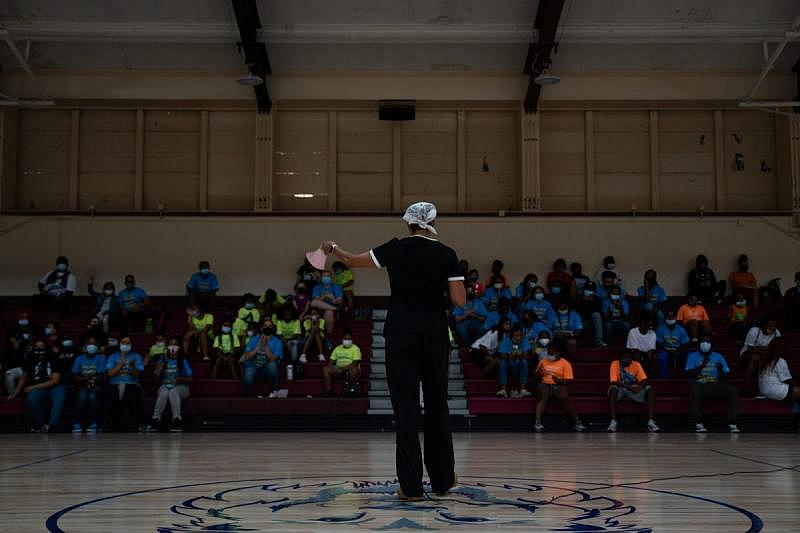
Dr. Kawanaa Carter has fought bureaucracy and vaccine hesitancy to bring vaccines to low income areas like the Marina Vista housing complex and the Martin Luther King Jr. Technology Academy. Dr. Carter says stepping up is a "moral issue and commitment." Credit: Louis Bryant III / OBSERVER
“It made many families really nervous, that if we did have the supply, then why was the vaccine being rolled out in certain communities that are not ‘hard to reach,’ and that’s not just with the County, but throughout the state. I don’t know the backstory of that. I’m not the one making the decisions on where they should go. All I know is that I was trying to fight to get them here.”
Making equity a real thing means public health officials need to move differently, Dr. Carter said.
“Make it a priority. It’s real simple,” she said. “They have the data. I work off their data, so I know they have the information. The real issue is that there’s just a failure to plan specifically for equity.”
Equity was an afterthought, she says.
“There’s no reason with the vaccine, why at the beginning when we had the data that Black people were dying at an exponential rate, why Black people were only 10% of those vaccinated as of February or March when 150,000 White people were vaccinated, but we had a mass clinic over at Jesuit (High School) and no clinics over in Del Paso Heights, North Highlands and in South Sac. Why are we the last to get that opportunity to get vaccinated and the first ones they leave when they need to move on to somewhere else? That to me is where the County can do better. Saying to someone like UC Davis, if they can’t do it, ‘Please stay. Can we partner with you to stay? How can we really help the people who need the help?’”
DOING WHATEVER IT TAKES TO PREPARE FOR DELTA VARIANT
The state opened back up on June 15. The tier system that categorized areas by their case rates and hospitalizations was dropped. Many of the related restrictions like not dining indoors and staying six feet apart were relaxed. Those who are fully vaccinated were also allowed to go into most public places without wearing masks or face coverings.
On the eve of reopening, Dr. Carter said Sacramento County was “in trouble.” And Dr. Kasirye’s confirmation that COVID cases and hospitalizations are again on the rise since June 15, echoes her assessment. Of the new COVID-19 cases reported in Sacramento County in the 30 days after California’s reopening, 22 percent were Black, according to Dr. Kasirye. That’s double the amount of cases the County had just prior to reopening.
There is more worry now as well, as variants to the original COVID-19 virus have surfaced. The number of people getting COVID-19 after being fully vaccinated is inching closer to 600, but all the new cases are people who hadn’t been vaccinated at all.
Jamie White, manager of the County’s Epidemiology Program, said while Alpha and Epsilon variants are most frequently seen locally, as of July 8, there had been 75 reported cases of the deadly Delta variant.
“We expect that it’ll become the most commonly circulating variant by the end of the summer,” Ms. White said.
“The Delta variant, we know, is more contagious,” Sacramento County’s Public Health Officer Dr. Kasirye said. “We do have concerns, especially for areas or communities where the vaccination rate is still low.”
In July, an outbreak of COVID cases at the State Capitol, among lawmakers and staffers who had reportedly been fully vaccinated, prompted County health officials to recommend a reversal of lessened restrictions and going back to requiring people to wear masks again, regardless of their vaccination status.
There’s still plenty to do.
Councilmember Vang and the Sacramento Alliance For Vaccine Equity still meets virtually every Tuesday to “strategize and restrategize” before clinic days on Fridays.
Dr. Carter has previously set end dates to her vaccination efforts but has blown past them several times. Her Kaiser grant goes through November and she’s eying a $1 million federal grant from the Health Resources and Services Administration to support the necessary work.
She knows she’ll eventually have to get back to her “day job” as a neurosurgeon and meet requirements necessary to maintain her certifications, but she considers the vaccination work “a different way” to heed the call to save lives.
“For me, it really is a personal and moral issue and commitment,” she said. “There’s a lot of ways that you can be impactful. This is just one that was right there in my face and it just seems like I had to help and do something.”


